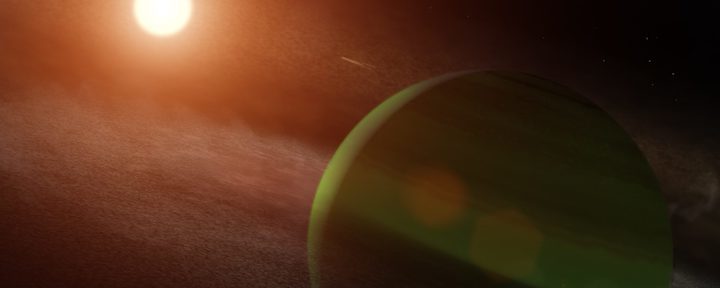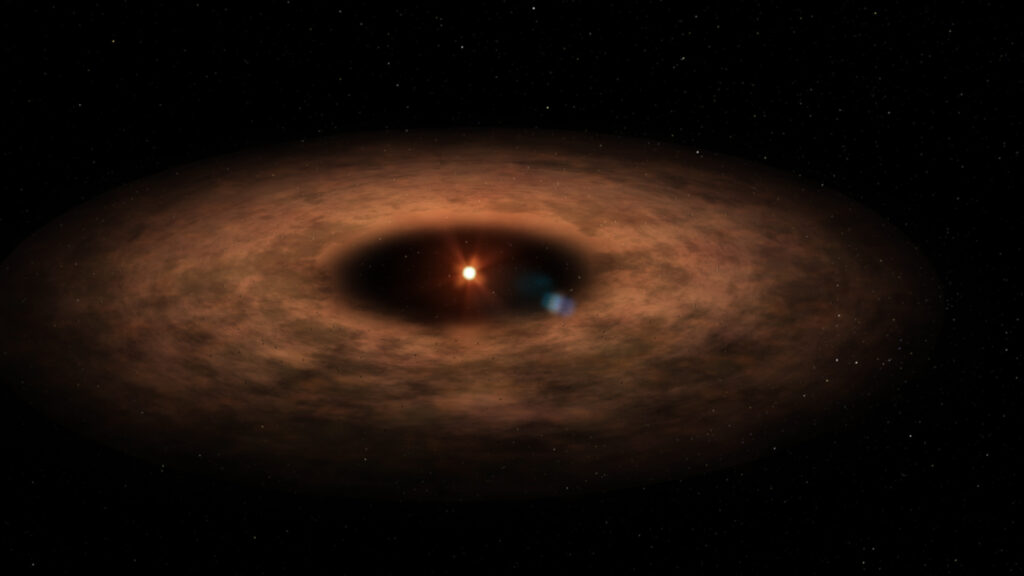26.06.2020

New research published today in Nature reports the discovery of a planet about the size of Neptune orbiting an especially young, nearby star. The planet, named AU Mic b, is orbiting AU Microscopii, which is relatively close to the Milky Way at 31.9 light years away. AU Microscopii is also “only” 20 or 30 million years old—at least 150 times younger than our Sun.
There are only two or three known stars that are both nearby and young, and scientists have been searching for planets orbiting them for at least a decade. This means the new finding creates a major opportunity for breakthrough research into solar system formation dynamics.
“One of the things we want to understand is, ‘When do planets form, and what do they do in their early days?’” says Tom Barclay. He’s an associate research scientist with UMBC’s Center for Space Sciences and Technology, a partnership with the NASA Goddard Space Flight Center in Greenbelt, Maryland.
Because AU Mic b is so young, Barclay adds, “studying this planet, and hopefully others like it, can give us insight into how our own solar system formed.”
Shining light on a new planet
Barclay primarily works on NASA’s Transiting Exoplanet Survey Satellite (TESS) mission. TESS observes the same section of sky for weeks at a time, collecting data about the brightness of stars in its field of view every two minutes. Thanks to this constant watchfulness, TESS can help detect planets by recording when a star’s brightness temporarily dims. That can sometimes signal a planet crossing in front of the star, or “transiting.”
“My role is to take the brightness data for the star and use that to understand what the size and other properties of the planet are,” says Barclay, who is second author on the new paper. Peter Plavchan of George Mason University leads the project. “Dips in brightness tell you about the size of the planet, and measuring how regularly spaced the transits are tells us how long it takes the planet to go around the star,” Barclay explains.
TESS detected two transits of AU Mic b, but the research team needed a third to “be confident that what we’d seen wasn’t something else in the data trying to fool us,” Barclay says. So they called on additional data collected by NASA’s Spitzer satellite and ground-based instruments in Hawaii and Chile.
Barclay analyzed the combined information and was able to confirm that AU Mic b has a mass of no more than 58 Earths and completes an orbit of AU Microscopii every 8.5 days. An orbit that short indicates that the planet is extremely close to the star.

Discovery dominoes
Next, Barclay and his colleagues want to learn more about the atmosphere of the new planet. Because it only recently formed, “it may well be losing its atmosphere at a rate that we can see,” Barclay says. “It might even appear somewhat teardrop-shaped, as the planet is moving and leaving some of its atmosphere behind. So we’re going to go and look for that.”
In addition to the rate of atmosphere loss, careful observations can also help determine what the planet’s atmosphere is made of. Determining the atmosphere’s components could help the team figure out where the planet formed, because certain substances can only exist at a known distance from the star.
Knowing where the planet formed would provide clues about how it had moved since it first came into being. And knowing that would get scientists closer to understanding more generally how planets form and migrate in a new solar system.
Planet migration puzzle
AU Mic b is likely primarily comprised of gases. “This star probably hasn’t had time to form small, rocky planets yet,” Barclay says. “It gives us a chance to get a picture of what might have happened before our own terrestrial planets like Earth and Venus formed.”
But the work is not easy. “Understanding the migration of planets is a really difficult problem. One of the fun things and one of the most frustrating things about studying stars is that we can never go to them,” Barclay says. “So this discovery is just one more puzzle piece in trying to understand what’s going on.”
Banner image: An interpretation of the appearance of AU Mic b (green) and its star, Microscopii. Image courtesy NASA’s Goddard Space Flight Center/Chris Smith (Universities Space Research Association)
